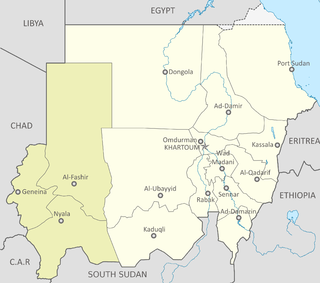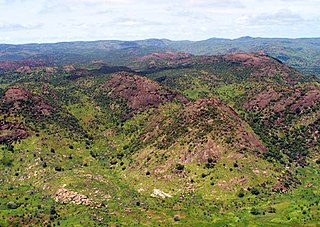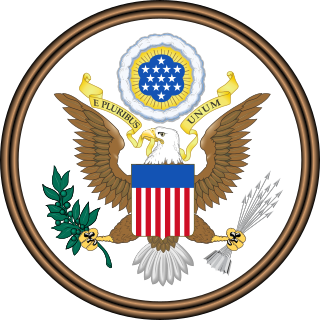 W
WThe Second Sudanese Civil War was a conflict from 1983 to 2005 between the central Sudanese government and the Sudan People's Liberation Army. It was largely a continuation of the First Sudanese Civil War of 1955 to 1972. Although it originated in southern Sudan, the civil war spread to the Nuba mountains and the Blue Nile. It lasted for 22 years and is one of the longest civil wars on record. The war resulted in the independence of South Sudan six years after the war ended.
 W
WThe Abyei Area is an area of 10,546 km2 or 4,072 sq mi on the border between South Sudan and Sudan that has been accorded "special administrative status" by the 2004 Protocol on the Resolution of the Abyei Conflict in the Comprehensive Peace Agreement (CPA) that ended the Second Sudanese Civil War. The capital of Abyei Area is Abyei Town. Under the terms of the Abyei Protocol, the Abyei Area was considered, on an interim basis, to be simultaneously part of both the Republic of South Sudan and the Republic of Sudan, effectively a condominium.
 W
WThe Assessment and Evaluation Commission (AEC) is a commission in the Republic of the Sudan that monitors and supports the implementation of the Comprehensive Peace Agreement (CPA). The AEC was charged to conduct a mid-term evaluation of the unity arrangements established.
 W
WDaud Yahya Ibrahim Bolad was a Sudanese politician and rebel leader.
 W
WThe Comprehensive Peace Agreement, also known as the Naivasha Agreement, was an accord signed on January 9, 2005, by the Sudan People's Liberation Movement (SPLM) and the Government of Sudan. The CPA was meant to end the Second Sudanese Civil War, develop democratic governance countrywide, and share oil revenues. It also set a timetable for a Southern Sudanese independence referendum.
 W
WJohn Garang de Mabior was a Sudanese politician and revolutionary leader. From 1983 to 2005, he led the Sudan People's Liberation Army during the Second Sudanese Civil War, and following a peace agreement he briefly served as First Vice President of Sudan for 3 weeks until his death in a helicopter crash on 30 July 2005. A developmental economist by profession, Garang was a major influence on the movement that led to the foundation of South Sudan.
 W
WRiek Machar Teny Dhurgon is a politician who serves as the first Vice President of South Sudan.
 W
WNew Sudan is a concept for restructuring the Sudanese state, which was proposed by the Sudan People's Liberation Army/Movement during the Second Sudanese Civil War. The original SPLA/M Manifesto outlined 'New Sudan' as a proposed united and secular Sudanese state. The vision of 'New Sudan' was developed by Dr. John Garang, who advocated the 'New Sudan' as a democratic and pluralistic state.
 W
WThe Nuba Mountains, also referred to as the Nuba Hills, is an area located in South Kordofan, Sudan. The area is home to a group of indigenous ethnic groups known collectively as the Nuba peoples. In the Middle Ages, the Nuba mountains probably had been part of the Nubian kingdom of Alodia. In the 18th century, they became home to the kingdom of Taqali that controlled the hills of the mountains until their defeat by Mahdi Muhammad Ahmad. After the Mahdi's defeat by the British, Taqali was restored as a client state. Infiltration of the Messiria tribe of Baggara Arabs has been influential in modern conflicts. Up to 1.5 million people live in the mountains mostly ethnic Nuba and small minority of Baggara.
 W
WThe War of the Peters was a conflict primarily fought between the forces of Peter Par Jiek and Peter Gadet from June 2000 to August 2001 in Unity State, Sudan. Though both were leaders of local branches of larger rebel groups that were involved in the Second Sudanese Civil War, the confrontation between the two commanders was essentially a private war. As Par and Gadet battled each other, the Sudanese government exploited the inter-rebel conflict as part of a divide and rule-strategy, aimed at weakening the rebellion at large and allowing for the extraction of valuable oil in Unity State. In the end, Gadet and Par reconciled when their respective superiors agreed to merge the SPDF and SPLA.
 W
WThe Southern Sudan Autonomous Region was an autonomous region that existed in Southern Sudan between 1972 and 1983. It was established on 28 February 1972 by the Addis Ababa Agreement which ended the First Sudanese Civil War. The region was abolished on 5 June 1983 by the administration of Sudanese President Gaafar Nimeiry. Revocation of southern autonomy was one of the causes of the Second Sudanese Civil War which would continue until January 2005, when southern autonomy was restored.
 W
WThe Sudan Peace Act is a United States federal law sponsored by Thomas Tancredo condemning Sudan for genocide. President George W. Bush signed the Act into law on October 21, 2002.
 W
WThe Dinka–Nuer West Bank Peace & Reconciliation Conference of 1999 was held in what was then the Southern part of Sudan. It is commonly called the "Wunlit Peace Conference" after Wunlit, the village where it was held in eastern Tonj County in Bahr El Ghazal. The conference brought together Nuer from Western Upper Nile and Dinka from Tonj, Rumbek, and Yirol. It is the most prominent and comprehensively documented case of a people-to-people peace process in what is now the Republic of South Sudan.